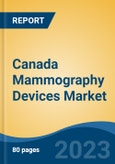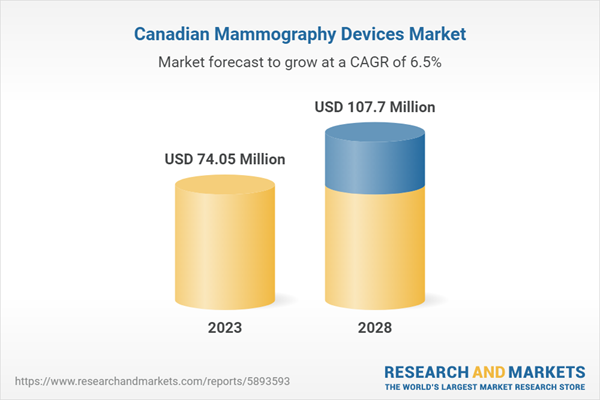Speak directly to the analyst to clarify any post sales queries you may have.
10% Free customizationThis report comes with 10% free customization, enabling you to add data that meets your specific business needs.
Increasing Prevalence of Breast Cancer
The increasing prevalence of breast cancer is a major driver of the growth of the Canada mammography devices market. Breast cancer is the most common form of cancer among Canadian women, and the incidence of the disease is expected to rise with the increase in growing population. Mammography is a crucial diagnostic tool for breast cancer, and it is recommended for women over the age of 50 to undergo regular mammography screening. As the prevalence of breast cancer increases, there is a growing demand for mammography devices to facilitate early detection and treatment of the disease. Early detection of breast cancer through mammography screening has been shown to improve treatment outcomes and reduce mortality rates. As a result, there is a growing awareness of the importance of mammography screening among women in Canada, which is driving the demand for mammography devices. In addition to the increasing prevalence of breast cancer, government initiatives aimed at improving access to mammography services are also driving the growth of the Canada mammography devices market. For example, the Canadian Breast Cancer Screening Initiative provides funding for mammography services across the country, which is helping to increase access to screening for women.Growing Awareness Of Breast Cancer Screening
The growing awareness of breast cancer screening is a key driver of the growth of the Canada mammography devices market. There is a growing recognition among women in Canada of the importance of regular mammography screening in detecting breast cancer at an early stage, which improves treatment outcomes and reduces mortality rates. The Canadian Cancer Society recommends that women aged 50-74 years undergo regular mammography screening every two years, and women aged 40-49 years should discuss the benefits and risks of screening with their healthcare provider. This recommendation, combined with the growing awareness of breast cancer screening, has led to an increase in the demand for mammography devices in Canada. As the demand for mammography devices increases, there is also a need for advanced technology that can provide accurate and efficient diagnoses. For example, digital mammography uses advanced imaging technology to produce high-quality images, which can help to improve detection rates and reduce the need for repeat testing. Moreover, as more women undergo regular mammography screening, there is also a growing need for qualified personnel to operate and interpret mammography results. This presents an opportunity for companies to invest in training and education programs to help ensure that there is a sufficient workforce of qualified mammography technologists to meet the growing demand.Technological Advancements
Technological advancements have a significant impact on the growth of the Canada mammography devices market. Advances in imaging technology, computer-aided detection (CAD) systems, and image analysis software have helped to improve the accuracy and efficiency of mammography screening, leading to better patient outcomes. One of the most significant technological advancements in mammography is the transition from film-based mammography to digital mammography. Digital mammography produces higher-quality images than film-based mammography, making it easier to detect small tumors and abnormalities. Digital mammography also allows for faster image acquisition and analysis, which can lead to quicker diagnoses and treatment. Another important technological advancement is the development of 3D mammography, also known as breast tomosynthesis. 3D mammography produces a series of images that can be viewed as individual slices, making it easier to detect tumors that might be hidden in overlapping tissue. This technology has been shown to improve the accuracy of breast cancer detection and reduce the need for additional imaging tests. CAD systems are also becoming increasingly common in mammography. These systems use algorithms to analyze mammography images and highlight areas that may require further investigation. CAD systems can help to reduce the number of false positives and false negatives in mammography screening, improving the accuracy of diagnoses. In addition to these technological advancements, there are ongoing developments in artificial intelligence and machine learning that are expected to further improve the accuracy and efficiency of mammography screening during the forecast period.Government Initiatives
Government initiatives have a significant impact on the growth of the Canada mammography devices market. The Canadian government has taken several measures to improve access to mammography services, which has helped to increase the demand for mammography devices. One of the key government initiatives is the Canadian Breast Cancer Screening Initiative (CBCSI). This program provides funding for mammography services across the country, which has helped to increase access to screening for women. The CBCSI also supports research into breast cancer screening and treatment, which has helped to improve the quality of mammography services. In addition to the CBCSI, the Canadian government provides funding for breast cancer research and education. This funding has helped to increase awareness of the importance of mammography screening among women, leading to an increase in the demand for mammography devices. The government has also implemented regulations and guidelines to ensure that mammography services are safe and effective. For example, Health Canada regulates the sale and use of mammography devices in Canada, ensuring that they meet safety and performance standards. The Canadian Association of Radiologists also provides guidelines for the use of mammography devices, helping to ensure that screening is conducted in a consistent and effective manner.Aging Population
The aging population in Canada is a significant driver of the growth of the mammography devices market. As women age, their risk of developing breast cancer increases, leading to a growing demand for mammography services. The Canadian population is aging rapidly, with an increasing number of women over the age of 50, which is the recommended age for regular mammography screening. According to Statistics Canada, in 2021, women over the age of 50 accounted for almost one-third of the female population in Canada. This demographic trend is expected to continue, leading to an increase in the demand for mammography services. In addition to the growing number of women over the age of 50, there is also a growing awareness of the importance of regular mammography screening among older women. Women over the age of 50 are more likely to have experienced breast cancer. As the demand for mammography services increases, there is also a need for advanced technology that can provide accurate and efficient diagnoses. For example, digital mammography is becoming increasingly common in Canada, as it produces high-quality images that can help to improve detection rates and reduce the need for repeat testing.Market Segmentation
The Canada mammography devices market can be segmented into product type, technology, end user, and by region. Based on product type, the market can be divided into full-field digital mammography, film-screen mammogram, and breast tomosynthesis. Based on technology, the market can be divided into digital and analog. Based on end user, the Canada mammography devices market can be grouped into hospitals & clinics, diagnostic centers, and others.Market Players
Siemens Healthcare Diagnostics Ltd/Canada, GE Healthcare Canada Inc., Philips Canada Ltd, Canon Medical Systems Corp, Carestream Health Canada Co, Hologic Inc, Analogic Canada Corp, and KUB Technologies Inc are some of the leading players operating in the Canada mammography devices market.Report Scope:
In this report, the Canada mammography devices market has been segmented into the following categories, in addition to the industry trends which have also been detailed below:Canada Mammography Devices Market, By Product Type:
- Full-Field Digital Mammography
- Film-Screen Mammogram
- Breast Tomosynthesis
Canada Mammography Devices Market, By Technology:
- Digital
- Analog
Canada Mammography Devices Market, By End User:
- Hospitals & Clinics
- Diagnostic Centers
- Others
Canada Mammography Devices Market, By Region:
- Ontario region
- Quebec region
- Alberta region
- British Columbia region
- Saskatchewan and Manitoba region
- Rest of Canada
Competitive Landscape
Company Profiles: Detailed analysis of the major companies present in the Canada mammography devices market.Available Customizations:
With the given market data, the publisher offers customizations according to a company’s specific needs.This product will be delivered within 1-3 business days.
Table of Contents
Companies Mentioned
- Siemens Healthcare Diagnostics Ltd/Canada
- GE Healthcare Canada Inc.
- Philips Canada Ltd
- Canon Medical Systems Corp
- Carestream Health Canada Co
- Hologic Inc
- Analogic Canada Corp
- KUB Technologies Inc
Table Information
| Report Attribute | Details |
|---|---|
| No. of Pages | 80 |
| Published | October 2023 |
| Forecast Period | 2023 - 2028 |
| Estimated Market Value ( USD | $ 74.05 Million |
| Forecasted Market Value ( USD | $ 107.7 Million |
| Compound Annual Growth Rate | 6.4% |
| Regions Covered | Canada |
| No. of Companies Mentioned | 8 |









